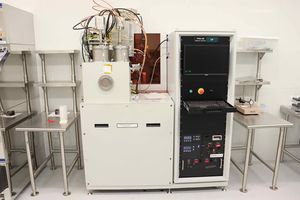Denton Explorer14 Magnetron Sputterer
 |
|
| Tool Name | Denton Explorer14 Magnetron Sputterer |
|---|---|
| Instrument Type | Deposition |
| Staff Manager | Sam Azadi |
| Lab Location | Bay 2 |
| Tool Manufacturer | Denton |
| Tool Model | Explorer14 |
| NEMO Designation | PVD-05 |
| Lab Phone | 215-898-9748 |
| SOP Link | SOP |
Description
Tool overview
The Denton Explorer-14 is a magnetron sputter deposition tool for depositing metallic and dielectric films (such as oxides). Sputter deposition is achieved by bombarding a source material with energetic ions, typically Ar+. Atoms at the surface of the target are knocked loose, and transported to the surface of the substrate, where deposition occurs. The tool is an open load system in sputter-down configuration with one dedicated DC source and two sources that can use either a DC or RF power supply. Co-deposition from two DC sources or one DC and one RF source is possible, but it is recommended to run co-deposition on PVD-03 as the sources in this tool are not in confocal mode per default. The tool is equipped with a cryo-pump, with an automated interface, accepting substrate sizes from pieces through wafers with 150 mm diameters. The tool has platen rotation and cooling.
Maximum power
- Maximum DC Power: 600 W.
- Maximum RF Power: 200 W.
You can inflict serious damage to the power supplies if these values are exceeded.
Main differences between PVD-05 (this tool) and PVD-03
There are several differences between our two sputtering tools. Think carefully about what your needs are before deciding what tool to get trained on. If you're ever in doubt, consult with staff.
PVD-05
- Large substrate platen that can hold several 4" wafers
- Water-cooled platen
- Three sputter sources (sputter down)
- This tool cannot sputter magnetic materials
- Open-load tool; requires at least one hour of pump-down
- Co-deposition can be done, but is not recommended (sources not in confocal mode per default)
PVD-03
- Small substrate platen that can hold one wafer up to 6"
- Four sputter sources (sputter up)
- This tool can sputter magnetic materials in source 2 and 4
- Load-lock tool; it takes approximately 7 min to load your sample
- This is our recommended tool for co-deposition as the sources are always confocal mode
Process data & master recipes
All process data were recorded at a base pressure lower than 5 x 10-6 Torr; you can never exceed 200 W on RF and 600 W on DC.
Clicking on the material's name will take you to the master recipe.
| Material name/link to master recipe | Max power | Process data | Recorded | Link to specs | ||
|---|---|---|---|---|---|---|
| Pressure | Power | Rate | ||||
| Ag (silver) | 450 W | 3 mTorr | 140 W | 7.3 Å s-1 | ||
| Al (aluminum) | 450 W | 3 mTorr | 200 W | 3.0 Å s-1 | ||
| Au (gold) | 140 W | 3 mTorr | 140 W | 4.6 Å s-1 | ||
| Cr (chromium) | 450 W | 3 mTorr | 450 W | 3.9 Å s-1 | ||
| Cu (copper) | 450 W | 3 mTorr | 400 W | 6.4 Å s-1 | Aug 18, 2023 | |
| Ge (germanium) | 140 W | - | - | - | ||
| ITO (Indium tin oxide) | 140 W | - | - | - | ||
| Mn (manganese) | 140 W | - | - | - | ||
| Mo (molybdenum) | 450 W | 3 mTorr | 140 W | 1.9 Å s-1 | ||
| Pd (palladium) | 140 W | - | - | - | ||
| Pt (platinum) | 140 W | 3 mTorr | 140 W | 2.6 Å s-1 | ||
| i-Si (intrinsic silicon) | 140 W | - | - | - | ||
| n-Si (n-type silicon) | 280 W | - | - | - | ||
| p-Si (p-type silicon) | 280 W | - | - | - | ||
| Ti (titanium) | 350 W | 3 mTorr | 350 W | 2.0 Å s-1 | ||
| TiO2 (titanium dioxide) | 140 W | - | - | - | ||
| W (tungsten) | 450 W | - | - | - | ||
| YSZ (yttria-stabilized zirconia) | 140 W | - | - | - | ||
Resources
SOPs & Troubleshooting
Target request form
Master recipes
The listed master recipes are what we used to obtain the process data listed above. We highly recommend our users to use these recipes. However, since they are free to edit, please always double check that the recipe is correct by consulting the charts below.
Note that some recipes have both ramp-up and ramp-down steps. The deposition step can always be found by locating when the shutter is open. The post-deposition cool-down time will vary for different materials depending on their propensity for oxidation. For example, Ag has a long cool-down time of 15 minutes.
All recipes should not be run at base pressures higher than 5e-6 Torr.